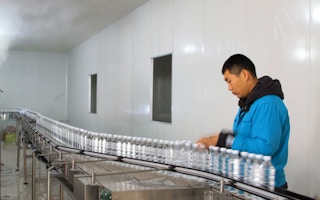On the shores of Bohai Bay near the industrial city of Tangshan, construction has begun on an engineering project ambitious even by Chinese standards.
Starting in 2019, the facility will remove salt from 120,000 tonnes of seawater each day. The result will be 50,000 tonnes of potable water, to be piped 170 miles to Beijing. The capital, located in the arid northeast, has scarce rainfall and dwindling water reserves.
Home to 20 per cent of the world’s population but only 7 per cent of its fresh water, China has embraced desalination. The central government’s Special Plan for Seawater Utilization calls for producing 3 million tonnes (807 million gallons) a day of purified seawater by 2020—roughly quadruple the country’s current capacity. Of China’s 668 largest cities, at least 400 already suffer from water scarcity.
Paul Bai, chief executive officer of Aqualyng China, a venture between Norway’s Aqualyng and Hong Kong-based Beijing Enterprises Water Group, says China is becoming a crucial market for foreign desalination companies with the latest technology and equipment.
“
The desalination market is very hot right now. The only challenge is the price.
Paul Bai, chief executive officer of Aqualyng China
“In terms of future potential, China may be the most important place.” he says. “The desalination market is very hot right now. The only challenge is the price.” Beijing pays 4 yuan (65¢) per cubic meter for tap water; desalinated water will cost 7 yuan, Bai says. “However, with fewer options” for new water sources, he adds, “desalination becomes more competitive.”
Aqualyng China is building and will operate the Tangshan plant. The International Desalination Association, a Boston-based trade group, reports that China is fifth in the world in installed desalination capacity; two years ago it ranked ninth.
According to state media reports, building the Bohai Bay plant will cost 7 billion yuan ($1.1 billion); the pipeline connecting it to Beijing, an additional 10 billion yuan. That doesn’t include the high electricity costs the plant will incur once it’s up and running.
The California-based Pacific Institute, an environmental group, estimates it takes 12,000 to 18,000 kilowatt hours to desalinate a million gallons of seawater. Pumping groundwater to the surface requires less than 4,000 kilowatt hours per million gallons.
Developed in the 1950s, desalination was until recently used mostly by wealthy desert countries such as Saudi Arabia, the biggest operator of desalination plants in the world. The two main ways to remove salt are reverse osmosis—pushing the water through membranes that trap salt and other particles—and multistage flash, which involves boiling seawater multiple times and collecting salt-free water vapor at each step.
The power required to propel water through the fine membranes or repeatedly raise it to a boil accounts for 30 per cent to 50 per cent of a plant’s operating cost.
Although the Chinese have the most ambitious plans, other countries, including Israel, Spain, the US, and Australia, have built or are building substantial facilities.
As California’s drought forced Governor Jerry Brown to announce rationing on April 1, San Diego was at the halfway point in the construction of a $1 billion desalination plant, slated to begin converting Pacific seawater into 50 million gallons of potable water daily by 2016. It will be the largest desalination plant in the Western Hemisphere.
The amount of power consumed by these plants concerns environmentalists. Washington-based World Resources Institute, a think tank devoted to the environment, warns that the high power demands of desalination will encourage more coal-burning and urban smog in China’s northern cities.
Coal-powered desalination isn’t the only option. The Perth Seawater Reverse Osmosis Plant, which opened in 2007 in Western Australia, draws energy from the state’s Emu Downs Wind Farm. And in January 2015, Saudi Arabia’s state-owned technology company Taqnia and Spanish energy company Abengoa announced construction of the world’s first solar-powered desalination plant, near Khafji.








